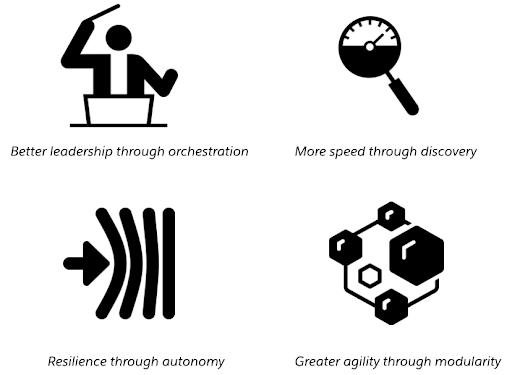We often hear the terms digital government, digital transformation in government, e-government, accelerating government in innovation, and so on. Why do these concepts generate so much excitement?
Well, the short answer is that they offer the potential to provide first-class experiences to citizens, and can increase government agility. That answer might seem abstract, but consider what has happened in the private sector. Consumers now have the option of watching any movie at home with just a few clicks instead of renting a limited number of DVDs. They can request a ride from their smartphones without calling a taxi. The list goes on. We can imagine similar first-class citizen experiences, but what about the government’s agility? Let us look into how private sector companies create an environment of fast change.
In the early 2000’s, the most common and convenient way to provide movies and TV shows was by using DVDs. At that time Blockbuster was the main rental provider of home movies and video games. But Netflix Founder and CEO Reed Hastings said in an interview in 2005 with inc. Magazine, “Movies over the internet are coming, and at some point it will become big business.” He was right — most of us have more than one media subscription to watch movies. In the private sector, it is a means of survival to see what is coming, then change and adapt. Netflix launched their streaming service in 2007, just two years after the Hastings interview. If you don’t adapt to fast-paced technology change you will be disrupted, as the Blockbuster example shows.
In this blog, we’ll show how governments can provide this same type of experience for citizens and keep up with the changes in the private sector.
A digital future for citizens
As a citizen, I want the same first-class user experience as the private sector for essential services that are vital to the health and welfare of my community in the public sector. The technology is there to make this more than a wish. By reimagining public sector experiences, we can make this a digital reality. For example:
- If medicaid, cash assistance, and food assistance application decisions were made in real-time, using an automated process where the results are ready in a few seconds.
- If your driver’s licence could be renewed in just a few clicks and mailed to your house within one-day shipping to enable you to commute safely and get access to other essential healthcare, financial, transportation, and logistic services.
- If you are working as a small business to improve energy efficiency, your grant application could be approved in a day instead of weeks.
We are not alone. A survey conducted by Accenture indicated 85% of respondents said they expect “the same or higher quality from government digital services” as they do from commercial organizations. So, what is blocking the government from achieving first-class citizen experience and agility?
The most common obstacles for governments are:
- Manual and outdated business processes that run on legacy systems, paper, or spreadsheets.
- Data trapped in different legacy systems where other lines of businesses have difficulty to find the right information.
- Collaboration between applicant and case workers or employees is inefficient and slow which results in poor customer service.
- It is difficult to interoperate within state departments and with other federal and state agencies.
- Policies and regulations.
- Difficulty in measuring and reporting on business outcomes.
The secret to solving these obstacles is understanding the business model of each agency. Most of the agencies and departments are created for the well-being of citizens, and the business model they follow is a value model, not a profit model. A composable approach will help agencies and departments handle rapid change, innovate quickly and adapt dynamically to enable this type of business model.
The value of composability
During the opening keynote at virtual Gartner IT Symposium/Xpo™ 2020, Distinguished VP Analyst Daryl Plummer, said, “Composable business is a natural acceleration of the digital business that you live every day. It allows us to deliver the resilience and agility that these interesting times demand.” Per Gartner, composable business means creating an organization made from interchangeable building blocks. The idea of composable business operates on four basic principles:
- Better leadership through orchestration
- More speed through discovery
- Resilience through autonomy
- Great agility through modularity

This type of thinking enables a business to survive, and even flourish, in times of disruption. When designing a composable business model it is important to understand the interoperability and exchange of value between departments within your agencies, partners and other stakeholders to meet the desired outcome. The value exchanged can be represented via a value network.
A value network is a set of connections between organizations and/or individuals interacting with each other to benefit the entire group. Interactions between agencies, departments, and people can help to achieve the wellbeing of citizens, provide first-class citizens experience, and achieve government agility. This interoperability can be automated via interconnected modular software systems to create a composable enterprise architecture.
The composable enterprise in public sector
According to Gartner, “a composable enterprise is an organization that delivers business outcomes and adapts to the pace of business change. It does this through the assembly and combination of packaged business capabilities (PBCs). PBCs are application building blocks that have been purchased or developed.” You can think of “business capabilities” as groupings of application functionality, like customer information updating or handling orders. In a composable enterprise, the “packaging” comes through APIs (application programming interfaces). Effective APIs are:
- Driven by business: Businesses are discovering valuable new uses for previously isolated data sources. APIs are the tools that allow businesses to put that data to use — by inspiring innovative developers to create new business opportunities and improve existing products, systems, and operations.
- Composable: Being able to innovate and adapt to changes business need by assembling and reassembling packaged business capabilities.
- Reusable building blocks: Packaged business capabilities are discovered, self-service and reused via the power of modern APIs by developers and other lines of business IT.
- Fast and agile by design: Designing and breaking complex problems into smaller modules and quickly developing solutions to each module through prototyping and feedback loop. Finally integrate each module solution to perform its desired business functions.
- Secure across endpoints: Packaged business capabilities that are exposed via modern APIs should be secured by latest security control according to the enterprise security standards.
- Governed: Run more efficiently by putting standards and governance on the modern APIs used to build packaged business capabilities in order to avoid brittle and bottleneck custom codes.
Public sector business models are about value overall, not just money. Value networks offer a way of mapping business models, by showing different value exchanges in the ecosystem. An organization’s business model is how it creates, delivers, and captures value within that value network/ecosystem. The components that create, deliver and capture value can be called “business capabilities.” Organizations that thrive in digital ecosystems make their business capabilities composable, using APIs as the interface.
In a recent Harvard business review article, Matt McLarty and Tiffany Xingyu Wang advise us — APIs Aren’t Just for Tech Companies. “You don’t have to be a tech company to reap the benefits of APIs — the opportunity exists in every industry. A transformation toward APIs would particularly benefit small to midsize companies that now struggle to reach digital audiences. APIs would position them to more easily offer products and services through emerging platforms, unbundle and rebundle their core competencies, and offload non-core competencies to third-party providers.”
To illustrate the benefits of composability, we can consider a number of public sector scenarios:
- The Department of Motor Vehicles (DMV) for a state or province could speed up their new driver licensing process through self-service options and better handoffs between private and public entities.
- A Health and Human Services (HHS) agency could provide more holistic, connected services by integrating with emergency relief providers and even factoring in consumer diet and activity data on an ongoing basis.
- Veterans Affairs — an agency established to provide government programs and benefits such as healthcare, life insurance, home loan, disability compensation, and education assistance for veterans — could streamline the veteran user experience and provide better access to services.
- Grants Management — an application that assists fund-seeking organizations such as non-profits and universities in administering the grant process — could be overhauled from a paper-based, disconnected manual process to an automated experience with digital observability across the complete grant lifecycle.
In future installments of this blog series, I will explore each of these examples in more detail, showing how value exchange mapping and API-led connectivity can lead from idea to implementation. In the meantime, check out these resources if you would like to learn more about value exchange and API business modeling through value exchange.
Special thanks to Matt McLarty for his contributions to this blog.









